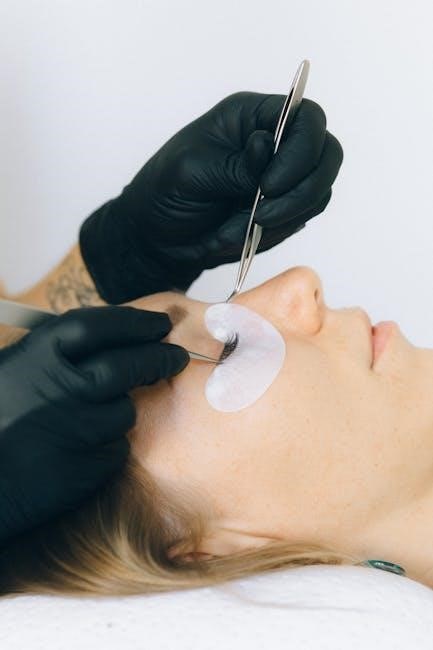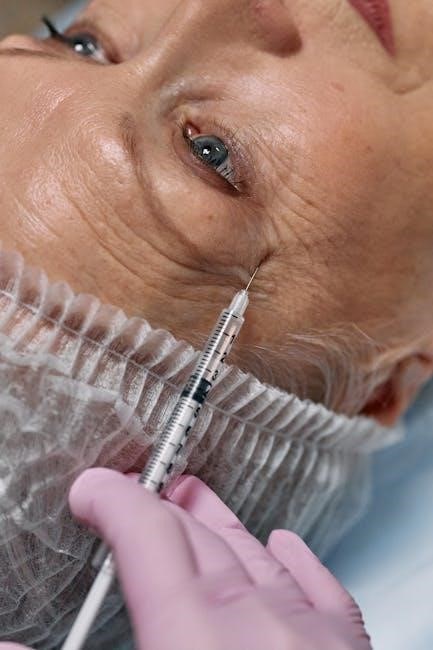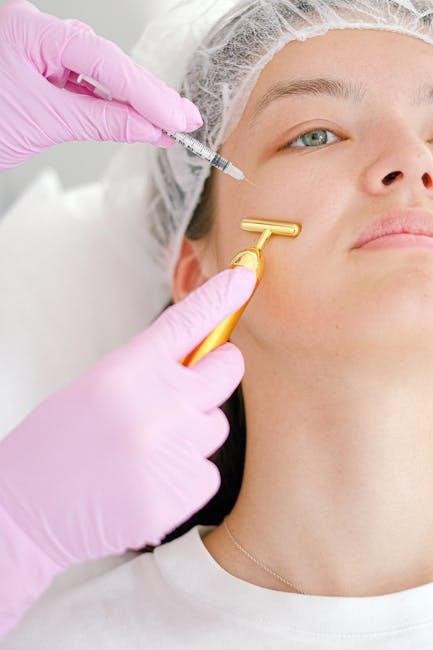Meralgia paresthetica is a neurological condition caused by the compression of the lateral femoral cutaneous nerve, leading to pain, numbness, and paresthesia in the outer thigh.
1.1 Definition and Overview
Meralgia paresthetica (MP), also known as Bernhardt-Roth syndrome, is a neurological condition characterized by the compression of the lateral femoral cutaneous nerve (LFCN). This results in sensory disturbances, such as pain, numbness, and paresthesia, primarily affecting the outer thigh. The term “meralgia” originates from the Greek words “meros” (thigh) and “algos” (pain). MP is often described as a burning, tingling, or itching sensation in the affected area. It is not caused by damage to the thigh itself but rather by nerve entrapment, making it a compressive mononeuropathy. Accurate diagnosis and management are crucial for symptom relief and improving quality of life.
1.2 Importance of Patient Education
Patient education is crucial in managing meralgia paresthetica, as it empowers individuals to understand their condition and actively participate in their care. Educating patients about symptoms, causes, and treatment options fosters better decision-making and adherence to therapy. It also encourages lifestyle modifications, such as weight management and activity adjustments, which are vital for symptom relief. Additionally, patient education addresses emotional and psychological aspects of chronic pain, reducing anxiety and improving overall well-being. Informing patients about when to seek medical help and how to monitor progress ensures timely interventions and prevents complications, making it a cornerstone of effective management.

Clinical Characteristics of Meralgia Paresthetica
Meralgia paresthetica is characterized by burning, tingling, or numbness in the outer thigh due to nerve compression, often without visible muscle weakness or reflex changes.
2.1 Symptoms and Presentation
Meralgia paresthetica typically presents with burning, tingling, or numbness in the outer thigh. Patients often describe a pins-and-needles sensation or discomfort that worsens with prolonged standing or walking. The symptoms are usually unilateral, affecting one side of the body, and may radiate across the anterolateral thigh. Some individuals report heightened sensitivity to light touch or clothing. These sensations can vary in intensity, ranging from mild discomfort to severe pain, and may worsen at night or with specific activities like tight clothing or prolonged sitting. The condition does not typically cause muscle weakness or reflex changes, focusing primarily on sensory disturbances.
2.2 Paresthesia and Pain Description
Meralgia paresthetica is characterized by paresthesia, often described as a burning, tingling, or itching sensation in the outer thigh. Pain can range from mild discomfort to severe, sharp, or stabbing sensations. The paresthesia may be constant or intermittent, often worsening with prolonged standing, walking, or wearing tight clothing. The discomfort typically occurs on one side of the body and is localized to the anterolateral thigh. While the symptoms can be distressing, they do not typically indicate permanent nerve damage, making early diagnosis and intervention crucial for effective management.
2.3 Sensory Loss and Tingling Sensations
Meralgia paresthetica often presents with sensory loss and tingling sensations in the anterolateral thigh. Patients may experience numbness or a reduced ability to feel light touch in the affected area. Tingling sensations can be described as pins and needles or a crawling feeling under the skin. These symptoms are typically unilateral and may worsen with prolonged standing, walking, or wearing tight clothing. The sensory disturbances can vary in intensity and may fluctuate throughout the day, often improving with rest or changing positions. Accurate diagnosis is essential to address the underlying nerve compression and alleviate these symptoms effectively.

Causes and Risk Factors
Meralgia paresthetica is primarily caused by compression of the lateral femoral cutaneous nerve, often due to tight clothing, obesity, or poor posture. Pregnancy and diabetes are also risk factors.
3.1 Nerve Compression and Pathophysiology
Meralgia paresthetica occurs when the lateral femoral cutaneous nerve (LFCN) is compressed, disrupting normal nerve function. This compression often happens near the inguinal ligament or within tight fascial compartments. The LFCN, responsible for sensation in the anterolateral thigh, becomes irritated, leading to abnormal nerve signaling. Prolonged compression can cause demyelination and axonal damage, resulting in pain, paresthesia, and sensory loss. The condition is exacerbated by factors like obesity, tight clothing, or repetitive hip flexion, which increase pressure on the nerve. Understanding this pathophysiology is key to effective diagnosis and treatment.
3.2 Contributing Factors and Triggers
Several factors contribute to the development of meralgia paresthetica, including obesity, tight clothing, and prolonged standing. Repetitive hip flexion, common in activities like cycling or hiking, can also trigger symptoms. Pregnancy, diabetes, and leg length discrepancies may increase susceptibility. External compression from belts or wallets can exacerbate nerve irritation. Understanding these triggers helps patients avoid aggravating activities and adopt preventive measures to reduce discomfort and manage the condition effectively.

Diagnosis and Assessment
Diagnosis involves a thorough clinical examination, patient history, and imaging studies to confirm nerve compression and rule out other conditions.
4.1 Clinical Examination and History
Diagnosis of meralgia paresthetica begins with a detailed clinical examination and patient history. Physicians assess symptoms such as numbness, tingling, and pain in the outer thigh. Tinel’s sign and reverse Tinel’s sign are often used to identify nerve compression. The examination focuses on the lateral femoral cutaneous nerve, evaluating sensory changes and pain upon pressure. Patient history helps identify contributing factors like weight gain, tight clothing, or prolonged standing. This comprehensive approach ensures accurate diagnosis and guides personalized treatment plans, emphasizing patient education for self-management.
4.2 Diagnostic Tests and Imaging
Diagnosing meralgia paresthetica often involves imaging and tests to confirm nerve compression. MRI and ultrasound are commonly used to visualize the lateral femoral cutaneous nerve and surrounding tissues. Electromyography (EMG) may assess nerve function and rule out other conditions. Nerve blocks with local anesthetics can confirm diagnosis by relieving symptoms. These tests help identify nerve compression sites and guide treatment. While imaging is useful, clinical examination and patient history often suffice for diagnosis. These diagnostic tools ensure accurate identification of meralgia paresthetica, allowing tailored treatment plans for symptom relief.

Treatment Options
Treatment for meralgia paresthetica includes conservative approaches like physical therapy, medications (e.g., gabapentin), and lifestyle changes. Nerve blocks and surgery are considered for severe cases.
5.1 Conservative Management Strategies
Conservative management for meralgia paresthetica focuses on alleviating symptoms and reducing nerve compression. This includes Kinesio taping to relieve pressure, soft-tissue therapy, and therapeutic exercises to improve mobility. Patient education on proper posture and activity modification is essential to prevent further nerve irritation. Weight management and avoiding tight clothing are also recommended to reduce pressure on the lateral femoral cutaneous nerve. These strategies aim to minimize discomfort and restore normal sensory function without invasive interventions.
5.2 Pharmacological Interventions
Pharmacological interventions for meralgia paresthetica aim to manage pain and inflammation. Common treatments include nerve block injections with anesthetic medications and anti-inflammatory agents. These injections target the affected nerve to provide relief. Additionally, oral medications such as non-steroidal anti-inflammatory drugs (NSAIDs) may be prescribed to reduce inflammation and alleviate discomfort. In some cases, corticosteroids are used to address swelling around the nerve. These treatments are often combined with other therapies to enhance their effectiveness and improve patient outcomes.
5.3 Physical Therapy and Exercise
Physical therapy and targeted exercises play a crucial role in managing meralgia paresthetica. Gentle stretching and strengthening exercises can help relieve pressure on the lateral femoral cutaneous nerve. Techniques such as clam exercises, where the patient lies on their side and bends the knees, can alleviate symptoms. Additionally, soft-tissue therapy and therapeutic exercises aimed at improving posture and reducing muscle tightness are beneficial. These interventions not only provide symptomatic relief but also enhance overall mobility and reduce the risk of recurrence, making them a cornerstone of conservative management for this condition.
5.4 Nerve Block Treatments
Nerve block treatments are a viable option for managing meralgia paresthetica, particularly in severe cases. These procedures involve injecting a local anesthetic, often combined with a corticosteroid, directly into the affected area to alleviate pain and inflammation. The treatment targets the lateral femoral cutaneous nerve, providing immediate and sometimes long-lasting relief. Nerve blocks are typically performed in a clinical setting and may require repeated sessions for sustained benefits. This approach is especially useful for patients who do not respond to conservative measures, offering a targeted solution to reduce discomfort and restore normal sensory function.

Surgical Interventions
Surgical options, such as nerve decompression, are considered when conservative treatments fail. Procedures are often outpatient, allowing patients to return home the same day.
6.1 Nerve Decompression Surgery
Nerve decompression surgery is a minimally invasive procedure to relieve pressure on the lateral femoral cutaneous nerve. The goal is to remove surrounding tissue or structures compressing the nerve, restoring normal function. This surgery is typically performed under local anesthesia and is effective when conservative treatments fail. Patients often experience immediate symptom relief, with high success rates reported. Recovery is generally quick, with most individuals resuming normal activities within a few days. However, as with any surgery, risks like infection or nerve damage exist, requiring careful patient selection and post-operative care.
6.2 Surgical Outcomes and Recovery
Most patients experience significant symptom relief following nerve decompression surgery, with improvement in pain and sensory disturbances. Recovery is typically rapid, allowing individuals to resume daily activities within a few days. Post-operative care includes wound management and avoiding direct pressure on the surgical site. Long-term outcomes are favorable, with minimal recurrence rates. Some patients may require physical therapy to restore full mobility and strength. Overall, surgical intervention provides a reliable solution for persistent meralgia paresthetica, offering lasting relief and improved quality of life for many individuals.

Lifestyle Modifications
Lifestyle changes, such as weight management, improving posture, and avoiding prolonged standing or tight clothing, can help alleviate symptoms and prevent meralgia paresthetica exacerbation.
7.1 Weight Management and Posture
Maintaining a healthy weight reduces pressure on the lateral femoral cutaneous nerve, easing symptoms. Good posture minimizes nerve compression; Avoid tight clothing and prolonged standing. Ergonomic adjustments at work and home can also help. Strengthening core muscles improves spinal alignment and reduces strain on the nerve. Regular exercises targeting posture and weight management are recommended. These lifestyle changes not only alleviate symptoms but also prevent recurrence of meralgia paresthetica, promoting long-term comfort and nerve health.
7.2 Activity Modification and Ergonomics
Modifying activities to avoid prolonged sitting, standing, or repetitive movements can reduce nerve compression. Ergonomic adjustments, such as using supportive chairs or standing desks, help alleviate pressure. Avoiding tight clothing that restricts the thigh area is also beneficial. Incorporating regular breaks to stretch and move can prevent nerve irritation. Patients should adapt their workspace and daily tasks to promote proper posture and minimize strain. These changes, combined with gentle exercises, can significantly reduce symptoms and improve overall comfort and mobility for individuals with meralgia paresthetica.

Patient Education and Self-Management
Patient education empowers individuals to understand their condition and implement self-management techniques, enhancing their ability to manage symptoms and improve quality of life effectively.
8.1 Understanding the Condition
Meralgia paresthetica is a neurological condition caused by the compression of the Lateral Femoral Cutaneous Nerve (LFCN), leading to pain, numbness, and tingling in the outer thigh. It is important for patients to recognize the symptoms, such as burning sensations or altered skin sensitivity, to seek timely medical advice. Understanding the condition helps patients engage in appropriate self-care and lifestyle modifications, reducing discomfort and improving quality of life. Education empowers individuals to manage their symptoms effectively and make informed decisions about their care.
8.2 Pain Management Techniques
Effective pain management for meralgia paresthetica often involves a combination of strategies. Conservative approaches include physical therapy, stretching exercises, and activity modification to reduce nerve irritation. Pharmacological options like NSAIDs or neuropathic pain medications may be prescribed to alleviate symptoms. Nerve blocks with local anesthetics or corticosteroids can provide temporary relief. Additionally, lifestyle changes, such as weight management and improving posture, can help reduce pressure on the affected nerve. Patient education on proper ergonomics and exercises is crucial for long-term symptom control and enhancing quality of life.

Prognosis and Long-Term Outlook
The prognosis for meralgia paresthetica is generally favorable, with most patients experiencing significant improvement or complete resolution of symptoms with appropriate treatment and lifestyle adjustments.
9.1 Expected Recovery and Symptom Relief
Most patients with meralgia paresthetica experience significant improvement in symptoms within a few months of treatment. Recovery often begins with relief from pain and paresthesia, followed by gradual restoration of normal sensation. Nerve decompression and physical therapy can accelerate healing, while lifestyle changes, such as weight management and improved posture, may prevent recurrence. Symptoms typically resolve completely in many cases, though some patients may have mild, intermittent tingling. The prognosis is favorable, with long-term relief achievable through a combination of conservative and, if necessary, surgical interventions.
9.2 Potential Complications and Recurrence
While meralgia paresthetica typically responds well to treatment, complications can arise if left unaddressed. Chronic nerve compression may lead to persistent pain or sensory deficits. Recurrence is possible, often due to unresolved risk factors like obesity or poor posture. In rare cases, nerve damage may result in permanent sensory changes. Prompt medical attention is crucial to prevent long-term complications. Patients should adhere to recommended lifestyle modifications and follow-up care to minimize the risk of recurrence and ensure optimal recovery.
Follow-Up and Monitoring
Regular follow-up appointments are essential to monitor symptom improvement and adjust treatment plans. Tracking progress ensures optimal recovery and addresses any recurring issues promptly.
10.1 Scheduled Medical Visits
Scheduled medical visits are crucial for managing meralgia paresthetica. Patients should attend regular check-ups to monitor symptom progression and treatment efficacy. During these visits, healthcare providers assess pain levels, sensory changes, and functional improvements. Adjustments to therapy, such as medication or physical therapy, may be made based on patient feedback. These visits also provide an opportunity to address any concerns or questions the patient may have, ensuring a personalized and effective care plan. Consistent follow-up helps prevent complications and promotes long-term recovery.
10.2 Tracking Progress and Adjusting Treatment
Regular monitoring of symptoms and treatment response is essential for managing meralgia paresthetica. Patients should track pain levels, sensory changes, and functional improvements. This information helps healthcare providers assess the effectiveness of the current treatment plan. Adjustments may include modifying medications, physical therapy routines, or lifestyle recommendations. Patient feedback is crucial for tailoring interventions to individual needs. Progress tracking also identifies potential complications early, allowing for timely interventions. Open communication between patient and provider ensures a dynamic and adaptive approach to care, optimizing outcomes and enhancing quality of life.

References and Further Reading
- Ann Surg, Arch Phys Med Rehabil, and Int J Sports Phys Ther provide comprehensive reviews on diagnosis and treatment.
- Guidelines from clinical experts and patient education handouts are available for further reading.
- Download the essential PDF patient guide for detailed insights and management tips.
11.1 Recommended Literature and Resources
For detailed insights, refer to Ann Surg, Arch Phys Med Rehabil, and Int J Sports Phys Ther, which provide comprehensive reviews on meralgia paresthetica.
- Download the PDF patient handout for practical advice and symptom management.
- Consult clinical guidelines from experts like Cheatham et al. for evidence-based treatments.
- Explore YouTube tutorials and chiropractic case reports for alternative therapies.
- Visit MedlinePlus and Mayo Clinic for reliable patient-focused information.
These resources offer a mix of academic and accessible content for both patients and professionals.
11.2 Clinical Guidelines and Expert Recommendations
Clinical guidelines recommend a multimodal approach for managing meralgia paresthetica, emphasizing non-invasive treatments first. Experts suggest starting with conservative management, such as physical therapy and pharmacological interventions like neuropathic pain medications. Nerve blocks are recommended for severe cases. Surgical decompression is considered only when conservative measures fail. Regular follow-ups and patient education are crucial for optimal outcomes. Referencing studies by Cheatham, Kolber, and Salamh provides evidence-based strategies. Always consult expert recommendations for personalized treatment plans tailored to patient needs and symptom severity.
Meralgia paresthetica can be effectively managed through conservative treatments, patient education, and, if necessary, surgical intervention, ensuring improved quality of life and symptom relief for patients.
12.1 Summary of Key Points
Meralgia paresthetica is a condition caused by compression of the lateral femoral cutaneous nerve, leading to pain, numbness, and paresthesia in the outer thigh. It often results from nerve entrapment due to factors like tight clothing or obesity. Symptoms include burning, tingling, or stinging sensations, typically worsening with prolonged standing or walking. Diagnosis involves clinical examination and imaging to rule out other conditions. Treatment options range from conservative approaches, such as weight management and physical therapy, to pharmacological interventions and, in severe cases, nerve decompression surgery. Patient education plays a crucial role in self-management and improving quality of life.
12.2 Encouragement for Patient Engagement
Patients are encouraged to take an active role in managing meralgia paresthetica by adhering to treatment plans and making lifestyle adjustments. Regular follow-ups with healthcare providers ensure personalized care and address any concerns promptly. Empowering oneself with knowledge about the condition fosters better decision-making and improves overall well-being. Engaging in recommended exercises, maintaining a healthy weight, and avoiding aggravating activities can significantly alleviate symptoms. Active participation in therapy and open communication with healthcare teams are key to achieving long-term relief and enhancing quality of life.